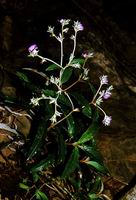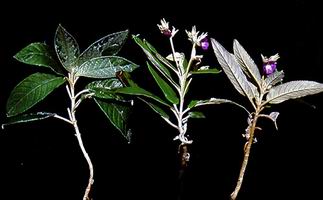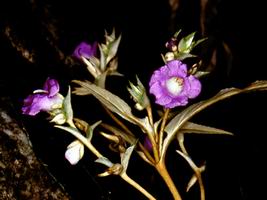

Penins. Malaysia, Langkawi Islands, phot. A. Weber (1986)
Full name and orig. publication: Trisepalum C.B.Clarke in A. & C.DC., Monogr. phan. 5: 138 (July 1883).
Etymology: From the Greek τρεις, treis = three, and the Latin sepalum = sepal; alluding to the (seemingly) trimerous calyx, in which the upper three lobes are fused ± to the tip, while the two lower ones are nearly free.
Synonyms: Dichiloboea Stapf (1913).
Infrafamilial position: Didymocarpoid Gesneriaceae - "Advanced Asiatic and Malesian genera" (Weber 2004).
Description: Perennial, rosulate or caulescent herbs, occasionally monocarpic, often woody in lower parts, sometimes with woody straggling branches, young stems densely woolly. Leaves opposite (? spiral in some rosulate species), with arachnoid tomentum, the hairs usually branched. Cymes axillary; branching variously di- or monochasial, sometimes combining to form a terminal thyrse; pedicels of a flower pair usually unequal. Bracteoles inconspicuous to very large, increasing in size in association with reduction in branching of inflorescence, when large overlapping to form a strobilus-like cone and inflorescence branches then very short. Sepals unequally connate to form a three-partite calyx. Corolla obliquely campanulate, white or light violet. Stamens 2, included; anthers with divergent thecae. Ovary conical-cylindrical; stigma linguiform, downcurved over mouth of corolla. Fruit a capsule, usually twisted and dehiscent along both carpels, occasionally along one only, occasionally not twisted and compressed.
Chromosome number: 2n = 36.
Species number: 13.
Type species: Trisepalum obtusum C.B.Clarke
Species names (incl. publication and synonyms): See Skog, L.E. & J.K. Boggan. 2005: World checklist of Gesneriaceae: http://persoon.si.edu/Gesneriaceae/Checklist.
Distribution: S China (S Yunnan), Burma, Thailand, N Malay Peninsula (Perlis, Langkawi Islands).
Ecology: On damp rocks, in or outside of forests.
Notes: The genus is closely allied to Paraboea (particularly closely related to the species with twisted fruits), and even can be regarded as a northern appendix of that genus. The essential distinctive character is the calyx: the three upper sepals are connate to form a shortly 3-dentate or undivided upper lip, while the two lower ones are free or shortly connate.
Selected references: Burtt, Notes Roy. Bot. Gard. Edinburgh 41: 401-452 (1984), rev.; Wang et al. in Wu & Raven (eds.), Fl. China 18: 370-371 (1998) (Chinese spp.); Burtt, Thai Forest Bull. (Botany) 29: 81-109 (2001), annot. checklist (Thailand).
Bibliography: See Skog, L.E. & J.K. Boggan. 2005. Bibliography of the Gesneriaceae. 2nd edition: http://persoon.si.edu/Gesneriaceae/Bibliography.
Illustrations:
 |

|
Trisepalum speciosum (Ridl.) B.L.Burtt
Penins. Malaysia, Langkawi Islands, phot. A. Weber (1986) |
 |
Trisepalum speciosum (Ridl.) B.L.Burtt
Penins. Malaysia, Langkawi Islands, phot. A. Weber (1986) |
last modified: 2007-07-13